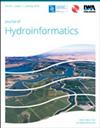Daily rainfall assimilation based on satellite and weather radar precipitation products along with rain gauge networks
IF 2.2
3区 工程技术
Q3 COMPUTER SCIENCE, INTERDISCIPLINARY APPLICATIONS
引用次数: 0
Abstract
Abstract The analysis of the spatial and temporal distribution of storm events contributes to a better use of water resources, for example, the supply of drinking water, irrigation practices, electricity generation and management of extreme events to control floods and mitigate droughts, among others. The traditional observation of rainfall fields in Mexico has been carried out using rain gauge network data, but their spatial representativeness is unsatisfactory. Therefore, this study reviewed the possibility of obtaining better estimates of the spatial distribution of daily rainfall considering information from three different databases, which include rain gauge measurements and remotely sensed precipitation products of satellite systems and weather radars. In order to determine a two-dimensional rainfall distribution, the information has been merged with a sequential data assimilation scheme up to the diagnostic stage, paying attention to the benefit that the rain gauge network density has on the estimation. With the application of the Barnes method, historical events in the Mexican territory were analyzed using statistical parameters for the validation of the estimates, with satisfactory results because the assimilated rainfalls turned out to be better approximations than the values calculated with the individual databases, even for a not very low density of surface observations.基于卫星和气象雷达降水产品及雨量计网的日降水同化
对暴雨事件时空分布的分析有助于更好地利用水资源,如饮用水的供应、灌溉方式、发电和极端事件的管理,以控制洪水和缓解干旱等。墨西哥降雨场的传统观测是利用雨量计网数据进行的,但其空间代表性不理想。因此,本研究考虑了来自三个不同数据库的信息,包括雨量计测量和卫星系统和气象雷达的遥感降水产品,审查了获得更好的日降雨量空间分布估计的可能性。为了确定二维降雨分布,在诊断阶段,将信息与序列数据同化方案合并,并注意雨量计网密度对估计的好处。应用Barnes方法,利用统计参数对墨西哥境内的历史事件进行了分析,以验证估计结果,结果令人满意,因为同化的降雨量比用单个数据库计算的值更好,即使对密度不是很低的地面观测也是如此。
本文章由计算机程序翻译,如有差异,请以英文原文为准。
求助全文
约1分钟内获得全文
求助全文
来源期刊

Journal of Hydroinformatics
工程技术-工程:土木
CiteScore
4.80
自引率
3.70%
发文量
59
审稿时长
3 months
期刊介绍:
Journal of Hydroinformatics is a peer-reviewed journal devoted to the application of information technology in the widest sense to problems of the aquatic environment. It promotes Hydroinformatics as a cross-disciplinary field of study, combining technological, human-sociological and more general environmental interests, including an ethical perspective.
 求助内容:
求助内容: 应助结果提醒方式:
应助结果提醒方式:


